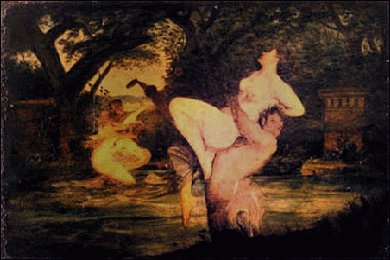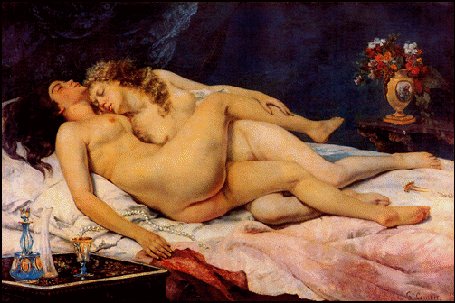Art and Artists
Collaborative Art
By Matthew Moss, Art Monte-Carlo
VERY FEW ARTISTS WHO VENTURE into the field of politics, be they ever so famous, emerge unscathed. The Greek sculptor Phidias (c.480 – 430 BC), oversaw the construction of the Parthenon on the Acropolis in Athens in the city's Golden Age under Pericles the city’s leading politician. Despite his contemporary fame Phidias fell victim to political infighting. Unable to attack Pericles directly political adversaries choose a weaker subject and arrested the sculptor with whom he was closely identified instead, accusing him of theft. An art form, peculiar to this period was the creation of Chryselephantine statues, a name given to works of art created from slabs of precious ivory representing the human form laid over a timber core and covered with gold plating and jewellery. These expensive creations represented the state’s treasury. Pieces of the often greater than life-size statues were dismantled and sold off when poor economic conditions compelled the treasury to dip into its resources, to be replaced when times got better. Amongst the chryselephantine statue commissioned by Pericles was the massive Parthenon Athena Parthenos covered in heavy gold plating. During Phidias’ trial the courts removed the Athena Parthenos gold and ivory to weigh the material and see if it corresponded to the proper weight as the artist was accused of embezzling some of the precious materials.
In 1482 Ludovico il Moro Duke of Milan, he who commissioned Leonardo da Vinci’s Last Supper in the refectory of Santa Maria delle Grazie, asked him to create a massive equestrian bronze statue in memory of his father Francesco Sforza. With the typical entrepreneurs habit of never refusing a contract Leonardo got as far as producing a life-size clay mock-up of the steed and stored it in a barn on the Milan outskirts while he went on to other projects.
In a political mis-calculation Ludovico invited France in 1494 to come to his aid during an inter-Italian conflict. This intervention opened the way for Louis of Orléans, later Louis XII, to make a claim on Milan and he invaded the city in 1499. During the occupation a group of Royal archers camped outside Milan discovered Leonardo’s massive equestrian statue and found it to be an ideal subject for target practice, eventually reducing it to ruins. The French takeover of Milan lead to the defeat and the downfall of Duke Ludovico Sforza who was captured and died in a French prison. Leonardo did not miss a beat, and Louis XII became his most important patron until the king’s death in 1514. Leonardo da Vinci eventually retired to a residence in the castle Cloux, Amboise in 1516 under the patronage of Louis' successor François I. His presence had long-term consequences for art in France including the development of the School of Fontainebleau and, in 1911 the subtraction by an Italian patriot of the Gioconda from the Louvre in Paris to Florence.
The difficult political and religious conditions prevailing in 16th. and 17th century Holland made it risky for the majority of artists to declare themselves in favour of any one particular sect or take a political stance. The exception was the mysterious Dutch artist Johannes Sijmonsz van der Beeck (Torrentius) born in 1589 who, as a result of his unorthodox beliefs and political allegiances, ended his life in prison. With the exception of ‘Fauns and Nymphs’, few of his works have survived. It is believed that the Haarlem authorities burned most of them during one of the intermittent iconoclasms that took place in Holland.

Johannes Sijmonsz van der Beeck (Torrentius) 1589–1644,
‘Fauns and Nymphs’. Notorious in his day for nonconformist
behaviour, immorality, blasphemy and painting indecent
pictures of which this is probably a good example.
They also arrested, tortured and condemned him in 1627 to twenty-two years in prison because of his preference for obscene subjects in his paintings, wayward conduct in his daily life and for being a member of the underground dissenter religious sect, the Rosicrucians. In some ways he was a Northern if lesser known, Caravaggio. The artist eventually was released by Frederik Hendrik the Stadholder in 1630 at the request of Charles l of England who admired the painter’s work and invited him there to work. The artist does not appear to have had much success in London and, despite the risks he was running preferred to return to Holland where he was quickly re-arrested and died in prison 55 years old.
Gustave Courbet was a French artist with a social conscience. He attempted to reform the corrupt French art establishment of his day by reforming the official French Academy, making Government art contracts more transparent and tried to break the Salon’s monopoly of exhibiting and sale of artists’ works. Courbet, headed the Arts Commission as a member of the Conseil de la Commune in 1871 Paris when he was involved with the short and bloody revolution defeated, eventually, by the Third Republic.
During the conflict the popular press depicted the artist single-handedly pulling down Napoléon’s bronze triumphal column in Place Vendôme. Courbet was arrested but was spared the fate meted out to thousands of fellow revolutionaries who were massacred. Instead, the courts condemned him to pay massive punitive damages for its destruction and re-erection, sums the artist lacked the ability to repay. Demonstrating the solidarity that traditionally exists between painters Jean-Louis-Ernest Meissonier a successful history and genre painter, helpfully suggested the authorities execute Courbet.
Courbet chose instead to leave France spending the rest of his life in Switzerland. He was following a tradition a number of notable artists of the period who, having been too closely identified with a particular regime, like Jacques-David, Brussels in 1815 and Goya in Bordeaux, 1824 thought it prudent to exile themselves in a neighbouring country as earlier on did Phidias himself.

Gustave Courbet’s 1866 'The Sleepers', Musée du Petit Palais, Paris.
Painted in a heavy-handed manner showing two hefty Victorian women
rather improbably posed on a bed. These female subjects not
to mention 'The Origin of the World', Musée d'Orsay, and 'Woman
with a Parrot', 1866 New York, Metropolitan Museum helped bring
the artist the notoriety he sought.
The German occupation of France from 1940-45, created unusual problems and hard choices for French artists who chose to remain. School of Paris painters of foreign or Jewish origin had little choice but to try and get away, usually through the Free–Zone port of Marseilles and Spain. During the initial period of panic Pablo Picasso with well-known Republican sympathies headed for Royan in his chauffeur-driven Hispano-Suiza. However, rethinking his options he returned to Paris instead relying for protection on his fame and wealth. Despite keeping his head down and refusing to exhibit during the Occupation his studio became one of the tourist attractions of Paris for German officials.
Henri Matisse’s situation was more complex. He stayed in Nice for the interval but was not hostile to Vichy itself, allowing them to show his paintings in Pétain government-sponsored exhibitions. Matisse, however, possessed somewhat limited options. He was very seriously ill and, in addition, his estranged wife and his daughter, both partisans, were in the hands of the Gestapo.
Picasso and Matisse’s contemporary, Jean Cocteau, on the other hand, made no attempt to conceal his enthusiastic collaboration with the occupying Germans. He eulogised the National-Socialist sculptor Arnold Breker’s exhibition of giant bronze statues held in 1942 occupied Paris. Hitler’s favourite artist had created his monumental statues with bronze foundered from Frances public statues and the labour of ill-treated French prisoner of war Breker used in his Berlin studio. Despite being ostracised after Liberation Cocteau survived. That his reputation remained intact in the post war era was shown when a sale of the artist’s works at Bonhams on 23rd. September 2010 made a significant £430,000 (€ 503,800) in sales. Earlier, in 2003, Menton town council had approved the creation of a Jean Cocteau museum, at the present writing nearing completion, on the seafront to house the Severin Wunderman collection.
Artists – unlike writers, such as Robert Brassilach, who were condemned to death and executed or spent long years in prison immediately after the Liberation – were given, at most, a slap on the wrist for their collabo activities, a sign, possibly, of how little importance the visual arts and artists have become as social markers.
If you need an appraisal of your old painting, contact Matthew Moss at Free Paintings Evaluation.



